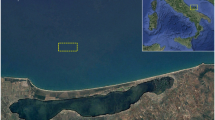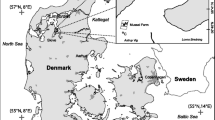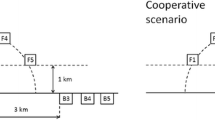Abstract
Purpose
Bivalve production is an important aquaculture activity worldwide, but few environmental assessments have focused on it. In particular, bivalves’ ability to extract nutrients from the environment by intensely filtering water and producing a shell must be considered in the environmental assessment.
Methods
LCA of blue mussel bouchot culture (grown out on wood pilings) in Mont Saint-Michel Bay (France) was performed to identify its impact hotspots. The chemical composition of mussel flesh and shell was analyzed to accurately identify potential positive effects on eutrophication and climate change. The fate of mussel shells after consumption was also considered.
Results and discussion
Its potential as a carbon-sink is influenced by assumptions made about the carbon sequestration in wooden bouchots and in the mussel shell. The fate of the shells which depends on management of discarded mussels and household waste plays also an important role. Its carbon-sink potential barely compensates the climate change impact induced by the use of fuel used for on-site transportation. The export of N and P in mussel flesh slightly decreases potential eutrophication. Environmental impacts of blue mussel culture are determined by the location of production and mussel yields, which are influenced by marine currents and the distance to on-shore technical base.
Conclusions
Bouchot mussel culture has low environmental impacts compared to livestock systems, but the overall environmental performances depend on farming practices and the amount of fuel used. Changes to the surrounding ecosystem induced by high mussel density must be considered in future LCA studies.




Similar content being viewed by others
References
ADEME (2008) Le traitement des ordures ménagères en France en 2008. Online: http://www2.ademe.fr/servlet/KBaseShow?sort=-1&cid=96&m=3&catid=24147
Aubin J (2013) Life cycle analysis as applied to environmental choices regarding farmed or wildcaught fish. CAB reviews: perspectives in agriculture, veterinary science, nutrition and natural. Resources 8(11)
Aubin J, Papatryphon E, Van der Werf HMG, Petit J, Morvan YM (2006) Characterisation of the environmental impact of a turbot (Scophthalmus Maximus) re-circulating production system using life cycle assessment. Aquaculture 261(4):1259–1268
Aubin J, Papatryphon E, van der Werf HMG, Chatzifotis S (2009) Assessment of the environmental impact of carnivorous finfish production systems using life cycle assessment. J Clean Prod 17:354–361
Ayer NW, Tyedmers PH (2009) Assessing alternative aquaculture technologies: life cycle assessment of salmonid culture systems in Canada. J Clean Prod 17(3):362–373
Basset-Mens C, Ledgard S, Boyes B (2009) Eco-efficiency of intensification scenarios for milk production in New Zealand. Ecol Econ 68:1615–1625
Basset-Mens C, Van der Werf HMG (2005) Scenario-based environmental assessment of farming systems: the case of pig production in France. Agric Ecosyst Environ 105:127–144
Boissy J, Aubin J, Drissi A, Van der Werf HMG, Bell GJ, Kaushik SJ (2011) Environmental impacts of plant-based salmonid diets at feed and farm scales. Aquaculture 321:61–70
Brenner M, Fraser D, Van Nieuwenhove K, O'Beirn F, Buck BH, Mazurié J, Thorarinsdottir G, Dolmer P, Sanchez-Mata A, Strand O, Flimlin G, Miossec L, Kamermans P (2014) Bivalve aquaculture transfers in Atlantic Europe. Part B: Environmental impacts of transfer activities Ocean & Coastal Management 89:139–146. https://doi.org/10.1016/j.ocecoaman.2013.10.009
Brigolin D, Dal Maschio G, Rampazzo F, Giani M, Pastres R (2009) An individual-based population dynamic model for estimating biomass yield and nutrient fluxes through an off-shore mussel (Mytilus galloprovincialis) farm. Estuar Coast Shelf S 82:365–376
Callier M, Weise AM, McKindsey CW, Desrosiers G (2006) Sedimentation rates in a suspended mussel farm (great-entry lagoon, Canada): biodeposit production and dispersion. Mar Ecol Prog Ser 322:129–141. https://doi.org/10.3354/meps322129
Callier M, McKindsey CW, Desrosiers G (2007) Multi-scale spatial variations in benthic sediment geochemistry and macrofaunal communities under a suspended mussel culture. Mar Ecol Prog Ser 348:103–115. https://doi.org/10.3354/meps07034
Callier MD, McKindsey CW, Desrosiers G (2008) Evaluation of indicators used to detect mussel farm influence on the benthos: two case studies in the Magdalen Islands, eastern Canada. Aquaculture 278:77–88
Chairattana C, Powtongsook S, Dharmvanij S, Manasveta P (2012) Biological carbon dioxide assimilation process using marine phytoplankton Tetraselmis suecica and bivalve Perna viridis. Environ. Asia 5(1):63–69
Chamberlain J, Fernades T, Read P, Nickel T, Davies I (2000) Impacts of biodeposits from suspended mussel (Mytilus edulis L.) culture on the surrounding surficial sediments. ICES J Mar Sci 58:411–416
Christenssen P, Glud R, Dalsgaard T, Gillespie P (2003) Impact of long line mussel farming on oxygen and nitrogen dynamics and biological communities of coastal sediments. Aquaculture 218:567–588
D’Amours O, Archambault P, McKindsey CW, Johnson LE (2008) Local enhancement of epibenthic macrofauna by aquaculture activities. Marine Ecology-Progress Series 371:73–84
Dabrowski T, Lyons K, Curé M, Berry A, Nolan G (2013) Numerical modelling of spatio-temporal variability of growth of Mytilus edulis (L.) and influence of its cultivation on ecosystem functioning. J Sea Res 76:5–21
FAO (2016) State of world fisheries and aquaculture 2016. Contributing to food security and nutrition for all. Food & Agriculture Org, Roma (Italia) 200 pp
FAO (2012) Mytilus edulis. http://www.fao.org/fishery/culturedspecies/Mytilus_edulis/fr
Filgueira R, Byron CJ, Comeau LA, Costa-Pierce B, Cranford PJ, Ferreira JG, Grant J, Guyondet T, Jansen HM, Landry T, McKindsey CW, Petersen JK, Reid GK, Robinson SMC, Smaal A, Sonier R, Strand Ø, Strohmeier T (2015) An integrated ecosystem approach for assessing the potential role of cultivated bivalve shells as part of the carbon trading system. Mar Ecol-Prog Ser 518:281–287
Fréchette M, Urquiza JM, Daigle G, Rioux-Gagnon D (2016) Clearance rate regulation in mussels: adding the effect of seston level to a model of internal state-based regulation. J Exp Mar Biol Ecol 475:1–10
Frischknecht R, Jungbluth N, Althaus HJ, Doka G, Dones R, Hirschier R, Hellweg S, Humbert S, Margni M, Nemecek T, Speilmann M (2004) Implementation of Life Cycle Impact Assessment Methods (version 1.1). Eco-Invent Report No. 3. Swiss Centre for Life Cycle Inventories, Dübendorf, 116 pp
Fry JM (2012) Carbon Footprint of Scottish Suspended Mussels and Intertidal Oysters. SARF 078, Final Report, Scottish Aquaculture Research Forum (SARF). Pitlochry, Perthshire, UK, 55 pp
Grant C, Archambault P, Olivier F, McKindsey C (2012) Influence of ‘bouchot’ mussel culture on the benthic environment in a dynamic intertidal system. Aquac Env Inter 2:117–131
Guinée JB, Gorrée M, Heijungs R, Huppes G, Kleijn R, de Koning A, van Oers L, Wegener Sleeswijk A, Suh S, Udo de Haes HA, de Bruijn H, van Duin R, Huijbregts MAJ (2002) Handbook on life cycle assessment. An operational guide to the ISO standards. Kluwer Academic Publishers, Dordrecht, The Netherlands, p 692
Henriksson PJG, Guinee JB, Kleijn R, Snoo GRD (2012) Life cycle assessment of aquaculture systems—a review of methodologies. Int J Life Cycle Assess 17:304–313
Henriksson PJG, Guinée JB, Heijungs R, Koning A, Green DM (2014) A protocol for horizontal averaging of unit process data—including estimates for uncertainty. Int J Life Cycle Assess 19:429–436
IPCC 2006 (2006) IPCC Guidelines for National Greenhouse Gas Inventories, Prepared by the National Greenhouse Gas Inventories Programme, Volume 5: Waste. Eggleston HS, Buendia L, Miwa K, Ngara T, Tanabe K (eds). IGES, Japan
Iribarren D, Moreira MT, Feijoo G (2010a) Revisiting the life cycle assessment of mussels from a sectorial perspective. J Clean Prod 18:101–111
Iribarren D, Moreira MT, Feijoo G (2010b) Implementing by-product management into the Life Cycle Assessment of the mussel sector. Resour Conserv Recy 54:1219–1230
Iribarren D, Moreira MT, Feijoo G (2010c) Life Cycle Assessment of fresh and canned mussel processing and consumption in Galicia (NW Spain). Resour Conserv Recy 55:106–117
ISO (2006a) EN ISO 14040: Environmental management—Life Cycle Assessment—principles and framework. European Committee for Standardization, Brussels, July 2006:20
ISO (2006b) EN ISO 14044: Environmental management— Life Cycle Assessment—Requierments and guidelines. European Committee for Standardization, Brussels, July 2006:20
Jansen HM (2012) Bivalve nutrient cycling—nutrient turnover by suspended mussel communities in oligotrophic fjords. Wageningen University, Wageningen 152 p
Joint Research Centre (JRC) (2010) International Reference Life Cycle Data System (ILCD) Handbook - General guide for Life Cycle Assessment - Detailed guidance. First edition March 2010. EUR 24708 EN. Publications Office of the European Union. Luxembourg. 417 p
Katajajuuri JM (2008) Experiences and improvement possibilities—LCA case study of broiler chicken production. Proceedings of the 6th International Conference on Life Cycle Assessment in the Agri-Food Sector. 12–14 November, Zurich, Switzerland
Lerman A, Mackenzie FT (2005) CO2 Air–Sea exchange due to calcium carbonate and organic matter storage, and its implications for the global carbon cycle. Aquat Geochem 11:345–390
Levasseur A, Lesage P, Margni M, Samson R (2013) Biogenic carbon and temporary storage addressed with dynamic life cycle assessment. J Ind Ecol 17:117–128
Lindahl O (2011) In: Shumway SE (ed) Mussel farming as a tool for re-Eutrophication of coastal waters: experiences from Sweden, in shellfish aquaculture and the environment. Wiley-Blackwell, Oxford. https://doi.org/10.1002/9780470960967.ch8
Lourguioui H, Brigolin D, Boulahdid M, Pastres R (2017) A perspective for reducing environmental impacts of mussel culture in Algeria. Int J Life Cycle Assess 22(8):1266–1277
McKindsey CW (2012) Carrying capacity for sustainable bivalve aquaculture. In: Meyers RA (ed) Encyclopedia of sustainability science and technology. Reference editorial office. Springer, New York, pp 1959–1976
McKindsey CW, Thetmeyer H, Landry T, Silvert W (2006) Review of recent carrying capacity models for bivalve culture and recommendations for research and management. Aquaculture 261(2):451–462
Mineur F, Belsher T, Johnson MP, Maggs CA, Verlaque M (2007) Experimental assessment of oyster transfers as a vector for macroalgal introductions. Biol Conserv 137:237–247
Mistri M, Munari C (2013) The invasive bag mussel Arcuatula senhousia is a CO2 generator in near-shore coastal ecosystems. J Exp Mar Biol Ecol 440:164–168
Munari C, Rossetti E, Mistri M (2013) Shell formation in cultivated bivalves cannot be part of carbon trading systems: a study case with Mytilus galloprovincialis. Mar Environ Res 92:264–267
Newell RIE, Koch EW (2004) Modeling seagrass density and distribution in response to changes in turbidity stemming from bivalve filtration and seagrass sediment stabilization. Estuaries 27(5):793–806
Nitschelm L, Aubin J, Corson MS, Viaud V, Walter C (2016) Spatial differentiation in Life Cycle Assessment LCA applied to an agricultural territory: current practices and method development. J Clean Prod 112:2472–2484
Nizzoli D, Welsh DT, Viaroli P (2011) Seasonal nitrogen and phosphorus dynamics during benthic clam and suspended mussel cultivation. Mar Pollut Bull 62:1276–1287
Papatryphon E, Petit J, Kaushik SJ, Van der Werf HMG (2004) Environmental impact assessment of salmonid feeds using Life Cycle Assessment (LCA). Ambio 33:316–323
Pelletier N, Tyedmers P (2008) Life cycle considerations for improving sustainability assessments in seafood awareness campaigns. Environ Manag 42:918–931
Pelletier NL, Ayer NW, Tyedmers PH, Kruse SA, Flysjo A, Robillard G, Ziegler F, Scholz AJ, Sonesson U (2007) Impact categories for life cycle assessment research of seafood production systems: review and prospectus. Int J. Life Cycle Assess 12:414–421
Petersen JK, Hasler B, Timmermann K, Nielsen P, Tørring DB, Larsen MM, Holmer M (2014) Mussels as a tool for mitigation of nutrients in the marine environment. Mar Pollut Bull 82(1–2):137–143
Richard M, Archambault P, Thouzeau G, Desrosiers G (2006) Influence of suspended mussel lines on the biogeochemical fluxes in adjacent water in the Iles-de-la-Madeleine (Quebec, Canada). Can J Fish Aquat Sci 63:1198–1213
Roque d'Orbcastel ER, Blancheton J-P, Aubin J (2009) Towards environmentally sustainable aquaculture: comparison between two trout farming systems using life cycle assessment. Aquac Eng 40(3):113–119
Swiss Center for Life Cycle Inventories (2013) Ecoinvent v3 Database. Ecoinvent Center (2013), Online: http://www.ecoinvent.org/
Tang Q, Zhang J, Fang J (2011) Shellfish and seaweed mariculture increase atmospheric CO2 absorption by coastal ecosystems. Marine Ecol Prog Series 424:97–104
Tanguy H, Ferlin P, Suche JM (2008) Rapport final de la mission sur le développement de l’aquaculture. Ministère de l’Agriculture et de la Pêche, Ministère de l’Ecologie, de l’énergie et du Développement Durable, Paris 62 p
Thrane M (2004) Energy consumption in the Danish fishery: identification of key factors. J Ind Ecol 8:223–239
USDA (2012) National Nutrient Database for Standard Reference. Basic Report: 15123, Fish, tuna, fresh, skipjack, raw. http://ndb.nal.usda.gov/ndb/foods/show/4603 (visited 12 Aug 2012)
Wilding TA, Nickell TD (2013) Changes in benthos associated with mussel (Mytilus Edulis L.) farms on the westcoast of Scotland. PLoS One 8:e68313
Williams AG, Audsley E, Sandars DL (2006) Determining the environmental burdens and resource use in the production of agricultural and horticultural commodities. Main Report Defra Research Project ISO205, Bedford: Cranfield University and Defra
Wolff JG, Beaumont A (2011) Shellfish sequestration: the augmented cultivation of Molluscs, and the preservation of their shells, as a means of sequestering carbon dioxide. Available. http://www.shellfishsequestration.org
Zeebe RE, Wolf-Gladrow D (2001) CO2 in seawater: equilibrium, kinetics, isotopes. Elsevier Oceanography Series, 65. Elsevier, Amsterdam, The Netherland, 100 pp
Acknowledgements
The authors thank Mytilimer SARL for their support and the farmers for their time and data provision. We also thank Michelle and Michael Corson for proofreading the manuscript’s English.
Author information
Authors and Affiliations
Corresponding author
Additional information
Responsible editor: Ian Vázquez-Rowe
Rights and permissions
About this article
Cite this article
Aubin, J., Fontaine, C., Callier, M. et al. Blue mussel (Mytilus edulis) bouchot culture in Mont-St Michel Bay: potential mitigation effects on climate change and eutrophication. Int J Life Cycle Assess 23, 1030–1041 (2018). https://doi.org/10.1007/s11367-017-1403-y
Received:
Accepted:
Published:
Issue Date:
DOI: https://doi.org/10.1007/s11367-017-1403-y




